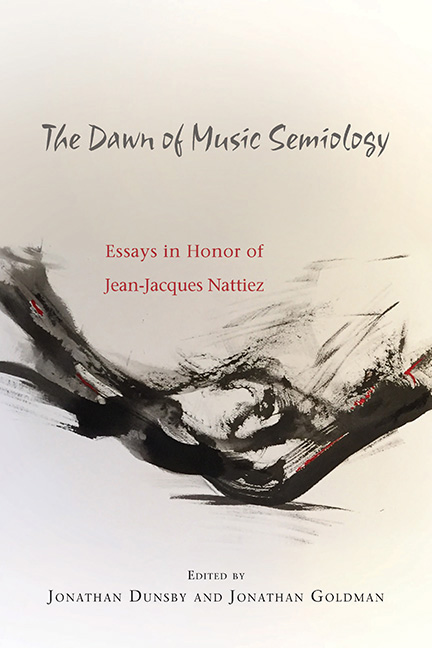Book contents
- Frontmatter
- Contents
- Foreword: About Jean-Jacques Nattiez
- Acknowledgments
- Introduction
- Part One Metaconsiderations
- Part Two Poietic Channels
- Part Three Esthesic Excursions
- 7 Musical Borrowings in the Works of Bruno Maderna
- 8 Of Doubles, Groups, and Rhymes: A Seriation of Works for Spatialized Orchestral Groups (1958–60)
- 9 The Psychological Organization of Music Listening: From Spontaneous to Learned Perceptive Processes
- Selected Bibliography of Works by Jean-Jacques Nattiez
- List of Contributors
- Index
- Tabula Gratulatoria
8 - Of Doubles, Groups, and Rhymes: A Seriation of Works for Spatialized Orchestral Groups (1958–60)
from Part Three - Esthesic Excursions
Published online by Cambridge University Press: 26 April 2018
- Frontmatter
- Contents
- Foreword: About Jean-Jacques Nattiez
- Acknowledgments
- Introduction
- Part One Metaconsiderations
- Part Two Poietic Channels
- Part Three Esthesic Excursions
- 7 Musical Borrowings in the Works of Bruno Maderna
- 8 Of Doubles, Groups, and Rhymes: A Seriation of Works for Spatialized Orchestral Groups (1958–60)
- 9 The Psychological Organization of Music Listening: From Spontaneous to Learned Perceptive Processes
- Selected Bibliography of Works by Jean-Jacques Nattiez
- List of Contributors
- Index
- Tabula Gratulatoria
Summary
Introduction
Methodological Considerations
Between March 1958 and October 1960, no fewer than six major works by prominent European avant-garde composers for multiple spatially distributed orchestral groups (with or without electronic sounds) received their first performances: Boulez's Doubles (which would later be expanded into Figures doubles prismes) and Poésie pour pouvoir; Karlheinz Stockhausen's Gruppen and Carré ; and Henri Pousseur's Rimes pour multiples sources sonores were sometimes premiered days apart, in key musical centers such as Paris, Cologne, and Donaueschingen. It is instructive to regard these key postwar modernist works as owing their existence in part to the specific characteristics of the historical era into which they were launched. One of the important developments of this era concerns music recording and sound reproduction, specifically the commercial introduction of stereo long-playing records that led to the mass distribution of stereo sound technology into homes throughout the Western world, including the introduction of commercially available stereo long-playing records in 1958. Stereo radio transmission also started to come of age over the course of the decade beginning in that year, and multichannel cinema sound systems were already commonplace in major urban centers around the world. To what extent were listeners’ experiences of the aforementioned spatialized works informed by their new familiarity with stereo sound? To what extent did composers respond to listeners’ expectations about, and understanding of, stereo in their spatialized works? The answers to these seemingly naive questions will require evaluating the extent to which an allusion to the technology of stereophony may have been inscribed into these works. This inscription might include both ways in which audiences were inclined to hear stereophonic effects in these works and ways in which composers might have reacted in their works to these expectations. Answering these questions also requires, on the poietic side of things, an evaluation of these composers’ constantly evolving discourses on their works’ relationship with technology (in order to reveal the ways in which they aim to position themselves strategically with respect to technological innovations of their time). On the esthesic flank, it requires an analysis of the extent to which the experience of two-channel stereophony lay at the horizon of contemporary listeners’ expectations.
- Type
- Chapter
- Information
- The Dawn of Music SemiologyEssays in Honor of Jean-Jacques Nattiez, pp. 139 - 176Publisher: Boydell & BrewerPrint publication year: 2017



